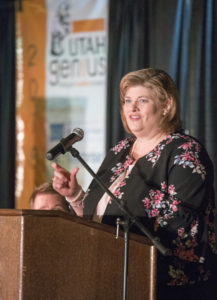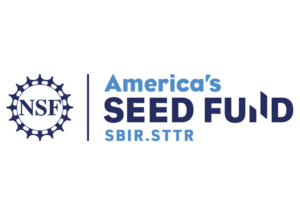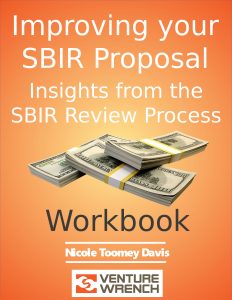40 Ways to Improve your SBIR Proposal!
 Hi, I’m Nicole Toomey Davis. I am a serial entrepreneur and my company has been awarded multiple SBIR awards worth over $1.2 million in SBIR funding. I have helped other entrepreneurs write winning proposals worth millions more. I have also served as an SBIR reviewer on over a dozen review panels.
Hi, I’m Nicole Toomey Davis. I am a serial entrepreneur and my company has been awarded multiple SBIR awards worth over $1.2 million in SBIR funding. I have helped other entrepreneurs write winning proposals worth millions more. I have also served as an SBIR reviewer on over a dozen review panels.
As an experienced Phase I and Phase II SBIR reviewer, I have seen so many silly and unnecessary mistakes kill a proposal, that I started writing them down to help other proposing teams improve their chance of SBIR success! I help entrepreneurs like you write successful and winning NSF SBIR or STTR proposals, NIH SBIR or STTR proposals, DOE proposals, DoD, NASA and more! SBIR is amazing source of non-dilutive Tech Funding and is one of the most unique innovation funding programs in the world.
I want to share my SBIR success insights, the insights from an experienced reviewer. I want to help you learn to WIN at SBIR! I want you to learn to Win the SBIR Game
My one of a kind online course, Develop a Winning SBIR Strategy – Insights From The Review Process, includes my insider insights into the review process – even though every agency reviews slightly differently, my experience as a reviewer is applicable to every agency!
In addition, I’ve added the results of my one on one discussions with senior SBIR personnel from most agencies, as well as helpful handouts, how-to’s, instructions and links from all the SBIR STTR programs. I help you learn how to decide which programs are the best for you to create your SBIR or STTR pipeline, and then help you go deep for every agency! In short, my goal is to help you develop your Winning SBIR Strategy.
The NSF says that they award about 10-15% of proposals, see #8 in the list. However, in my experience, on a panel reviewing 10 proposals, there are usually 1 or 2 proposal that are “fundable”. VERY rarely are there 3. All of the rest of them are unfundable, usually for dumb reasons, 40 of which I detail in this free report!
 Let me repeat that. The majority of proposals reviewed by the NSF (and other SBIR and STTR agencies) are UNFUNDABLE.
Let me repeat that. The majority of proposals reviewed by the NSF (and other SBIR and STTR agencies) are UNFUNDABLE.
They’re not even in the running. They never had a chance at getting an SBIR award – even after spending 200 or more hours of intense work creating the proposal. And usually, they are unfundable because of the kinds of mistakes I have outlined in this free report! Just by avoiding these mistakes, you put yourself in that very top tier of fundability. And being in that tier makes it far more likely that your proposal will be funded!
Sign up Below Get the Full, Free Guide: 40 Ways to Improve your SBIR Proposal.
Our unique List of Forty ways to improve your SBIR proposal!
Read the examples below and sign up below to get your copy of our free report detailing all 40 ways to improve your SBIR proposal!
1. Read the Solicitation.
6. Demonstrate your ability to take a product to market (either through revenue or through past successful commercialization efforts).
8. One Program Director put it this way – the NSF Phase I award rate is about 10%, but if you are 1) clear about the Innovation and 2) clear about the market, you are ahead of about 60% of the proposals!
10. Ask for the maximum amount that is permitted (to the penny!). If it is $150k max, ask for $150k, if it is $225k, then ask for $225k. Leftover money doesn’t help the Program Director.
24.Don’t assume that your Phase II reviewers have your Phase I proposal, they usually cannot see it and only a few of the reviewers may have been a reviewer on the your Phase I proposal. Pretend you are starting from scratch with every reviewer.
28. Don’t ever make a Program Director say “The PI is not coachable”! Can you say Death Knell?
It is hard f or proposing teams to imagine that these simple mistakes can eliminate them from consideration, but the reviewers are very experienced. Typically review panels include current or former SBIR / STTR PI’s or award recipients, as well as traditional research grant recipients (university researchers), experienced consultants and entrepreneurs, depending upon the agency. They know what to look for, they know what makes a winning team and they often review many proposals over many years, so they know what the Program Director is looking for.
or proposing teams to imagine that these simple mistakes can eliminate them from consideration, but the reviewers are very experienced. Typically review panels include current or former SBIR / STTR PI’s or award recipients, as well as traditional research grant recipients (university researchers), experienced consultants and entrepreneurs, depending upon the agency. They know what to look for, they know what makes a winning team and they often review many proposals over many years, so they know what the Program Director is looking for.
These are specific real mistakes from real proposals and I wrote these lessons down right away! First I got to 10, then 18, then 30, and I quit at 40.
These are all “real world” mistakes that I have personally seen as a reviewer that have eliminated otherwise quality proposals from consideration!
Let me repeat that, these simple mistakes ELIMINATED a proposal from even being considered for funding. Remember SBIR funding over all Phases can be worth millions in non-dilutive funding (and it keeps rising!)! Bummer for all those teams who lost out – don’t be one of them. Sign up below to get your copy of our free report detailing all 40!
These mistakes apply to both SBIR Phase I and SBIR Phase II proposals as well as their STTR counterparts. Even though most of these mistakes were made by teams proposing to the NSF SBIR STTR program, they apply to all of SBIR and STTR programs, including DoD SBIR and DoD STTR (which includes DARPA SBIR STTR), DOE SBIR and STTR, NSF SBIR STTR, Navy SBIR, Army SBIR, Air Force SBIR (and STTR for all services), NIH SBIR/STTR, and NASA SBIR STTR as well as DoED and other smaller programs such as NIST SBIR, DHS SBIR and EPA SBIR.
Now I want to let you know that, in addition to our free guide (available below), I have a detailed, hands-on course to help you to improve your SBIR or STTR proposal.
————————–
We share the full list of Forty with members of our VentureWrench SBIR Community.
Fill in the form below to Get the Full List of Forty ways to improve your SBIR proposal!
 Why should you care about the SBIR and STTR programs? The Small Business Innovation Research (SBIR) program and the companion, although slightly different, Small Business Technology Transfer (STTR) programs provided a combined total of over $3.73 Billion (SBIR.gov) in early stage, non-dilutive funding for America’s small technology businesses in 2019. The programs are referred to as “America’s Seed Fund” and are the single largest source of early stage funding for deep technology in the U.S. Crucially for entrepreneurs, SBIR and STTR awards are either grants or contracts rather than either loans or investment. The entrepreneur gives up no equity and has no repayment requirement providing they complete the work outlined in the SBIR grant or SBIR contract.
Why should you care about the SBIR and STTR programs? The Small Business Innovation Research (SBIR) program and the companion, although slightly different, Small Business Technology Transfer (STTR) programs provided a combined total of over $3.73 Billion (SBIR.gov) in early stage, non-dilutive funding for America’s small technology businesses in 2019. The programs are referred to as “America’s Seed Fund” and are the single largest source of early stage funding for deep technology in the U.S. Crucially for entrepreneurs, SBIR and STTR awards are either grants or contracts rather than either loans or investment. The entrepreneur gives up no equity and has no repayment requirement providing they complete the work outlined in the SBIR grant or SBIR contract.
The programs are administered in two phases. Phase I awards help the agency assess the capabilities of the small business and is the opportunity for the business to demonstrate the feasibility of their technology approach. About half of Phase I awardees win Phase II funding to further develop their proposed innovations. Phase I awards can total over $250,000, depending upon the agency, while Phase II awards can top $1.68 million (and rising). Both phases may include enhancements and matching funds to outside investment depending on agency specifics.
Make sure you can write a winning grant proposal so that you can get your share of the grant funding or contract funding available from these programs.
Sign up Below Get the Full (FREE!) List of Forty ways to improve your SBIR proposal!
By entering your email in the box above, you confirm that you have read and agree to our terms of service, and privacy policy and agree to receive more information from us.
